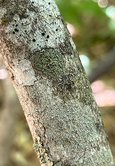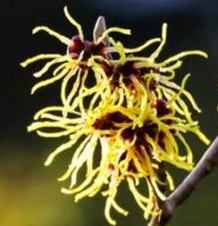
Note the wavy edges (leaf margin) and overall oval shape of the witch-hazel leaves.
The marvelous witch-hazel tree came to mind recently as I was dabbing witch hazel astringent on blackfly bite. This fascinating tree did not get its name for any association with witch lore but instead from the traditional use of its forked limbs as dowsing rods. In the hands of a dowser, the forked branch would "wych" or bend in a "wicke", meaning lively, way when underground water was detected. Up through the early 1900s dowsers were routinely hired to locate water before a well was dug.

Witch-hazel, also know as American witch hazel, is found throughout most of Maine and within the USA predominately east of the Mississippi River. Look for this small tree or shrub in semi-shaded areas of woodlands and on north facing slopes in rich moist soils. Its arching branches arise out of multi-stemmed clumps and reach all of 12 to 15 feet in height. (Photo is close-up of the bark.) The large leaves, up to 6 inches long, are easy to remember by their wavy edges. And, be sure to peek underneath to compare the the green of both the top and bottom surface of the leaves.
|

Get to know this tree now and then look for the moth-pollinated flowers that bloom during autumn on trees that are at least six years old. The bright yellow slender petals of the flower look gloriously messy - steaming out like mini golden fireworks. The shiny black paired seeds are a bit like fireworks too. They remain dormant over the winter and remain in their capsule until the following autumn when they are shot out from ten to twenty feet to land on the forest floor where they will mature for another year before germinating.
|
Share Nature Note with your friends, family, teachers, scouts, and anyone you think might be interested. Here is how they can sign up for a free subscription:
Read back issues online.
Suggest a topic by email; put Nature Note in Subject line and email Jocelyn Hubbell.
|